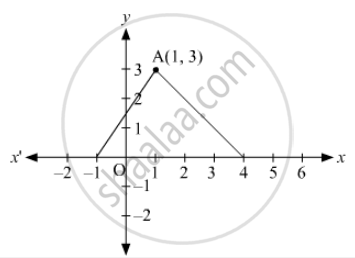Advertisements
Advertisements
प्रश्न
If A(–2, 1), B(a, 0), C(4, b) and D(1, 2) are the vertices of a parallelogram ABCD, find the values of a and b. Hence find the lengths of its sides
उत्तर
We know that diagonals of a parallelogram bisect each other.
Coordinates of the midpoint of AC = coordinates of the midpoint of BD
the midpoint of AC = midpoint of BD
`=> ((4-2)/2, (b+1)/2) = ((a+1)/2 , (0 +2)/2)`
`=> (2/2, (b+1)/2) = ((a+1)/2 , 2/2)`
`=> (1, (b+1)/2) = ((a+1)/2 , 1)`
So
`1 = (a+1)/2``
2 = a + 1
`:. a = 1`
and
`(b +1)/2 = 1`
`=> b + 1 = 2`
`:. b = 1`
Therefore, the coordinates are A(–2, 1), B(1, 0), C(4, 1) and D(1, 2).
`AB = DC = sqrt((1+2)^2 + (0 - 1)^2) = sqrt(9 + 1) = sqrt(10)`
`AD = BC = sqrt((1+2)^2 + (2-1)^2) = sqrt(9 + 1) = sqrt10`
APPEARS IN
संबंधित प्रश्न
A (3, 2) and B (−2, 1) are two vertices of a triangle ABC whose centroid G has the coordinates `(5/3,-1/3)`Find the coordinates of the third vertex C of the triangle.
Find the ratio in which the line segment joining (-2, -3) and (5, 6) is divided by y-axis. Also, find the coordinates of the point of division in each case.
In what ratio does the point P(2,5) divide the join of A (8,2) and B(-6, 9)?
In what ratio does the line x - y - 2 = 0 divide the line segment joining the points A (3, 1) and B (8, 9)?
Find the area of the triangle formed by joining the midpoints of the sides of the triangle whose vertices are A(2,1) B(4,3) and C(2,5)
Prove that the diagonals of a rectangle ABCD with vertices A(2,-1), B(5,-1) C(5,6) and D(2,6) are equal and bisect each other
Find the point on x-axis which is equidistant from points A(-1,0) and B(5,0)
Find the centroid of ΔABC whose vertices are A(2,2) , B (-4,-4) and C (5,-8).
If the points A (2,3), B (4,k ) and C (6,-3) are collinear, find the value of k.
Show that ΔABC, where A(–2, 0), B(2, 0), C(0, 2) and ΔPQR where P(–4, 0), Q(4, 0), R(0, 2) are similar triangles.
Show that A (−3, 2), B (−5, −5), C (2,−3), and D (4, 4) are the vertices of a rhombus.
If A(−3, 5), B(−2, −7), C(1, −8) and D(6, 3) are the vertices of a quadrilateral ABCD, find its area.
If the point P (m, 3) lies on the line segment joining the points \[A\left( - \frac{2}{5}, 6 \right)\] and B (2, 8), find the value of m.
What is the area of the triangle formed by the points O (0, 0), A (6, 0) and B (0, 4)?
Two vertices of a triangle have coordinates (−8, 7) and (9, 4) . If the centroid of the triangle is at the origin, what are the coordinates of the third vertex?
Write the condition of collinearity of points (x1, y1), (x2, y2) and (x3, y3).
The distance of the point (4, 7) from the x-axis is
In Fig. 14.46, the area of ΔABC (in square units) is

Find the coordinates of the point of intersection of the graph of the equation x = 2 and y = – 3
The point at which the two coordinate axes meet is called the ______.
